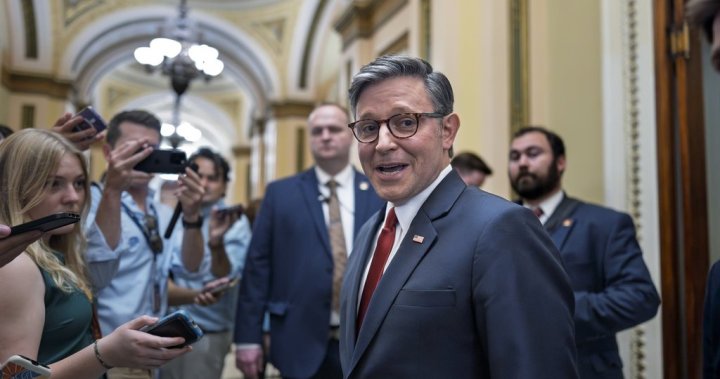I just returned from a three-day marathon on Capitol Hill where sleep-deprived lawmakers, bleary-eyed staffers, and a rotating cast of lobbyists navigated the most consequential economic legislation in decades. What began as Trump’s campaign promise for “the biggest tax cut in American history” morphed into something far more complex – a sprawling $4.5 trillion economic package that reshapes America’s tax code while unexpectedly embracing climate initiatives.
“We’re calling it the Big Beautiful Bill,” President Trump declared yesterday from the Rose Garden, flanked by Republican congressional leaders and, surprisingly, a handful of Democratic senators who crossed party lines. “Nobody thought we could do it. Nobody. But we got it done, and it’s going to be fantastic for American workers.”
The legislation, formally titled the American Economic Renewal and Energy Security Act, passed with a 54-46 Senate vote following last week’s narrow House approval. The bill represents Trump’s most significant legislative achievement since beginning his second term, though its contents reveal unexpected compromises that have left parts of his base confused.
Walking through the Capitol rotunda Wednesday night, I overheard Senator James Lankford (R-OK) tell a colleague, “This isn’t what we campaigned on, but it’s what we could get through. The climate stuff was the price of admission.”
That “climate stuff” includes $850 billion in clean energy tax credits – a stunning reversal from Trump’s first-term environmental deregulation agenda. The package extends and expands investment credits for domestic solar manufacturing, hydrogen production, and nuclear power while creating new incentives for carbon capture technology.
Treasury Secretary Scott Bessent, widely credited as the architect behind the package, defended the climate provisions to skeptical conservatives. “This is about energy dominance and manufacturing jobs, not climate activism,” Bessent told reporters yesterday. “Every dollar here serves American industrial interests first.”
The Congressional Budget Office projects the legislation will add approximately $3.2 trillion to federal deficits over the next decade, substantially less than early estimates. Markets responded positively, with the Dow Jones Industrial Average climbing 2.3% following passage.
For average Americans, the bill’s impact will be far-reaching. Households earning under $400,000 will see an average tax cut of $3,200 annually through 2028, according to Treasury Department analysis. The corporate tax rate drops from 21% to 15%, while introducing a controversial 20% minimum tax on unrealized capital gains for individuals worth over $100 million.
“We’re fixing the broken tax system by making the wealthy pay their fair share while cutting taxes for working families,” said Senate Majority Leader Mitch McConnell, whose support proved crucial despite early reservations about deficit impacts.
Democrats remain divided on the package. Progressive wing leaders including Alexandria Ocasio-Cortez condemned the corporate rate reduction as “a giveaway to billionaires,” while moderates like Senator Jon Tester of Montana praised the bill’s rural infrastructure investments.
“I’ve never seen such strange political bedfellows,” remarked veteran Senate staffer Marina Delaney, who has worked on tax legislation since the 1986 reform. “The coalitions forming around different provisions cross every ideological line imaginable.”
The most contentious element may be the bill’s border carbon adjustment mechanism, which imposes tariffs on imports from countries without equivalent environmental standards. Chinese officials have already threatened retaliatory measures, with Foreign Ministry spokesperson Wei Fenghe calling it “green protectionism disguised as climate action.”
American manufacturers, however, celebrated the provision. “This levels the playing field against countries that undercut American businesses by ignoring environmental costs,” said Jennifer Bailey, president of the American Steel Alliance, whose members stand to benefit significantly.
For energy-producing states, the legislation creates a $200 billion “transition fund” for communities historically dependent on fossil fuels. West Virginia Senator Joe Manchin, who helped broker key compromises, called it “recognition that we can’t leave coal country behind while building tomorrow’s energy economy.”
Implementation begins January 2025, with the IRS already warning of administrative challenges. “We’ll need to hire approximately 5,000 additional personnel to manage these changes,” IRS Commissioner Danny Werfel testified last week.
Having covered tax policy for nearly two decades, I’ve never witnessed legislation with such contradictory elements. Environmental groups praise the clean energy investments while criticizing continued fossil fuel subsidies. Deficit hawks condemn the overall price tag while supporting specific tax cuts. America First advocates celebrate reshoring provisions while questioning international climate commitments.
“This is what governance looks like in a divided country,” explained Dr. Elaine Kamarck from the Brookings Institution. “Nobody gets everything they want, but everyone gets something they need.”
For ordinary Americans wondering what this means for their wallets, the answer varies widely by income, location, and industry. The package’s complexity ensures its impact will unfold gradually over years rather than months.
As the dust settles on Capitol Hill, one thing remains clear: America’s economic landscape has been fundamentally altered. Whether these changes deliver on their promised benefits – jobs, growth, energy security, and climate progress – will likely determine not just the legislation’s legacy, but potentially the political futures of those who supported it.






